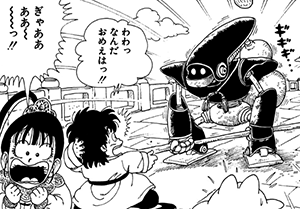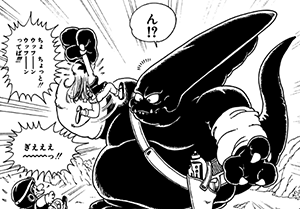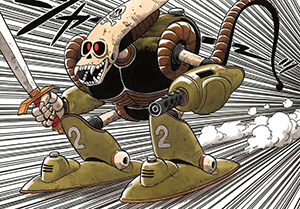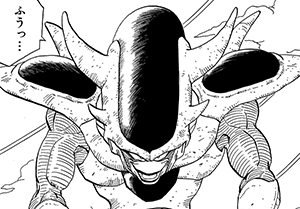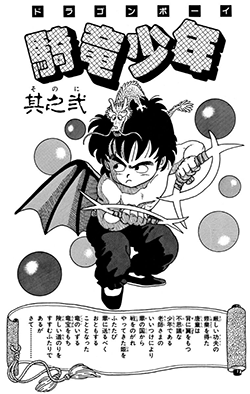
騎竜少年 其之弐
Doragon Bōi Sono Ni
Dragon Boy: Part Two
Chapter Information
| Premiered: | 22 September 1983 (Monthly Fresh Jump, October 1983 Issue) |
| Corresponding: | n/a |
|
|
|
| Availability: |
Bird Land Press 15 (November 1984); Akira Toriyama Preservation Society (fan club) newsletter
Dragon Ball Adventure Special (18 November 1987); mook Akira Toriyama’s ____piece Theatre, Vol. 2 (10 March 1988); tankōbon An Emperor’s Feast of Akira Toriyama, Vol. 1 (08 August 2008); bunko |
Chapter Summary
Tangtong continues flying toward the Flower Kingdom, sleeping princess in tow. The two stop for a bite to eat; they are only a tenth of the way there, and Tangtong needs to get his strength back with a little grub! He brought two rice balls that his master provided, but the princess is not interested, exclaiming that she wants soup instead.
Behind the bushes, two little ears pop out. Tangtong turns at the rustling sound and finds a polite young man who introduces himself as Pingyao, who is on a journey of his own toward Mt. Tinghao. Tangtong asks where Pingyao’s bags are; after all, he is a traveler and should have something with him. Pingyao stammers for a moment and then says that some thieves stole it. Pingyao notices the princess’s uneaten rice ball and asks if he can have it since he has not eaten in a day. Though welcoming of his compliments, the princess screams for Tangtong to give up his rice ball… but he has already eaten it, so the princess hands over hers.
Tangtong thinks to himself that this “Pingyao” has a demonic ki and must not be human. As soon as he gets the rice ball, Pingyao poofs back to his actual form: a sort of blobby, floating cat. Tangtong is angry over this trick and starts to walk over to beat up Pingyao, who turns into a rock to protect himself. Tangtong smiles, points to a similar rock beside them, and proceeds to smash it to smithereens with a single punch. Pingyao turns back to normal and runs away, apologizing for his actions. The princess asks Tangtong why he didn’t do more to punish Pingyao, but it was just a rice ball, and they have to get moving again, anyway.
The two next come across a giant bridge. The princess wants them to fly across, but will settle for being carried. They notice a large castle in the distance, when Pingyao suddenly rushes in to warn them of impending doom! Pingyao is actually 250 years old, and he tells them about a monster that took up residence here about 100 years ago and attacks anyone who tries to cross the bridge. Tangtong is not worried and insists that he will just beat up any bad guys they come across.
Just then, a large monster rushes in and smacks Tangtong over the head with a staff. As the princess pees her pants and Tangtong continues to be assaulted, Pingyao yells out that this is a machine soldier from Heyun. Tangtong notices how this machine appears to be rather damaged; for the last 100 years, it has probably been following its programming to protect the castle! Tangtong manages a few flips and attacks, but nothing is getting through to the machine, so Tangtong instead tries to reason with it. The princess is not helping at all, interrupting Tangtong to ask that he not spill the beans about her accident. Distracted, Tangtong gets knocked off the bridge. Pingyao panics as the machine raises its hands to attack the princess, but it is at this moment that Tangtong bursts from the river, wings outstretched, knocking the machine over. This doesn’t seem to be enough, so Tangtong figures he will have to keep fighting.
A voice suddenly shouts for them to stop: a soldier has arrived, telling the machine that it has protected the castle well, but it can rest now. With a tear dropping from its eye, the machine thanks the soldier and shuts down. Finally safe, the soldier poofs back to reveal that it was Pingyao! The princess, still completely oblivious to their situation, figures she can avoid embarrassment after ruining her clothes by having Pingyao transform into a new set of clothes. While they manage to make it to the castle, Pingyao suddenly transforms back to normal, leaving the princess completely naked; like Ultraman, he can only transform for three minutes at a time.
The Flower Country is still very far away….
Chapter Notes
Publication
-
Original Serialization: Monthly Fresh Jump
The second Dragon Boy chapter debuted in the October 1983 issue of Fresh Jump, which served as a launching point for new authors, various one-shots, etc. By this point, the magazine was now monthly, having switched from a bimonthly format earlier that year. -
Fanclub Newsletter: Bird Land Press
The second Dragon Boy chapter was reprinted in the 18th issue of Bird Land Press (dated May 1985), the newsletter of the Akira Toriyama Preservation Society (the author’s official fanclub). -
Guide Book: Dragon Ball Adventure Special
The Dragon Ball series’ first guide book, the Adventure Special from November 1987, reprinted both chapters of Dragon Boy as well as The Adventure of Tongpoo. -
Compilation Reprint #1: Akira Toriyama’s ____piece Theatre
Both Dragon Boy chapters were compiled in the second volume of Akira Toriyama’s ___piece Theatre (鳥山明○作劇場 Toriyama Akira Maru-saku Gekijō) volume, a 1988 tankōbon release collecting Today’s Highlight Island, Escape, Pink, both chapters of Dragon Boy, The Adventure of Tongpoo, Mr. Hō, Kennosuke-sama, and Sonchoh. This collection was rereleased, with some changes to the order and exact contents of each volume, under the convenience-store exclusive Shueisha Jump Remix branding/format in 2003. -
Compilation Reprint #2: An Emperor’s Feast of Akira Toriyama
Both Dragon Boy chapters were compiled in 2008’s first An Emperor’s Feast of Akira Toriyama (鳥山明満漢全席 Toriyama Akira Mankanzenseki) volume, a bunko release collecting Sonchoh, Lady Red, Mr. Hō, both chapters of Dragon Boy, and Go! Go! Ackman.
Chronology
Around this time, Akira Toriyama was at chapter 189 in Dr. Slump (released 20 September 1983 in the 1983 #42 issue of Weekly Shōnen Jump), a series he would be wrapping up the following August with chapter 236. Previous professional one-shots up to this point had included:
- 1978: Wonder Island, Wonder Island 2
- 1979: Today on Hairai Island, Gal Detective Tomato
- 1981: Pola & Roid, Escape
- 1982: Mad Matic, Pink
- 1983: Chobit, Chobit 2
Series & Chapter Title
- The series’ name is provided with a Japanese title of 騎竜少年, which would normally be read as Kiryū Shōnen, or “Riding Dragon Boy”. The furigana of ドラゴンボーイ (Doragon Bōi) accompanying the name, however, indicates an intended pronunciation and title of “Dragon Boy”.
- The second chapter is simply listed as 其之弐 (sono ni, or simply “Part Two”) with no formal title.
Characters
- Pingyao:
The shape-shifting monster’s name is written in kanji as 苹妖 with furigana indicating a Japanese-approximated ぴんやお pronunciation of Pinyao. In Chinese (píng yāo), this means “apple ghoul”. - Heyun Robot:
The robot “speaks” in katakana; Toriyama (and other writers) use this technique to emphasize their robotic speech pattern and sound, much like using all-caps in English.
Locales
- Heyun:
The opening narration says that Tangtong and the princess have entered the water country of “Heyun”, written in kanji as 河運 with furigana indicating an approximate Japanese pronunciation of はーゆん hāyun. In Chinese (héyùn), this means “river transport”. - Mt. Tinghao:
Pingyao tells the princess that he is heading to Mount “Tinghao”, written in simplified Chinese characters as 听好, with furigana indicating an approximate Japanese pronunciation of ちんはお chinhao. In (simplified) Chinese (tīng hǎo), the mountain’s full name literally means “Mt. ‘Sounds Good'”.
Author’s Comment
-
Each issue of Fresh Jump featured short comments from the various series’ authors, giving fans a brief insight into their current thoughts, ranging from series-related announcements to trivial happenings in their personal lives. Akira Toriyama’s comments from this issue were:
奥さんが山ほどの中国の資料をもっているのですごく参考になってます! <明>
My wife has a mountain of materials on China, which is really coming in handy! <Akira>Toriyama is likely referring to the Chinese-inspired locales and naming conventions within Dragon Boy. Toriyama’s wife, Yoshimi (née Katō), a.k.a. Nachi Mikami, is a former cartoonist who has assisted her husband in drawing and coming up with ideas. The couple married in May 1982.
Connections & References
- Pingyao’s introduction is akin to Oolong’s in Dragon Ball, while his actual form (a sort of flying cat) is more akin to Pu’er’s. Tangtong’s scolding him and subsequent teamwork is also quite reminiscent of later Oolong and Pu’er interactions.
- Tangtong becoming tired from flying is something that will later resurface with the formal Bukujutsu (ki-based flying) technique in Dragon Ball, though here it is likely just physical exhaustion from using his wings.
- The Heyun robot design is similar to that of the xenomorphs in the Alien franchise, a design that has been and will continue to be used for various aliens, monsters, and robots over the course of Toriyama’s career.
- Pingyao’s limited transformation time (three minutes) is reminiscent of Oolong’s own transformation issues in Dragon Ball. The citation of Ultraman is also classic Toriyama; Arale frequently expressed her love for and imitated the character back in Dr. Slump.
Interview References
Dragon Boy has been cited by name several times following Dragon Ball‘s publication.
- In the Shenlong Times supplemental pamphlet accompanying the second Daizenshuu in 1995, Akira Toriyama and his original editor Kazuhiko Torishima touched on Toriyama’s work post-Dr. Slump:
Torishima: While we were thinking of what to do for the next serialized work after Dr. Slump ended, Toriyama drew various one-shots for Weekly Jump and Monthly Fresh Jump.
Toriyama: I certainly did draw a lot of them. I had, who knows how many, painstaking meetings with Torishima-san.
Torishima: But the reception wasn’t very good.
Toriyama: Even though we had all these painstaking meetings. (laughs)
Torishima: Then after Dr. Slump ended, there was a good response to Dragon Boy, which had been drawn without too many meetings beforehand.
Toriyama: With that nice response, I felt “Ah, there’s this track, this just might work out.” And this time I had wanted a boy as the protagonist.
— Akira Toriyama & Kazuhiko Torishima, Dragon Ball Daizenshuu 2: Story Guide Supplemental Shenlong Times Pamphlet (read full interview) - In his 2004 Dragon Ball Landmark interview, Toriyama retold the story of having to take up a new work following the completion of Dr. Slump:
I was incredibly happy that Dr. Slump became popular, but at any rate, weekly serialization is hard, and coming up with material got more and more difficult… I was always wondering how I’d be able to end it. Then, I was told, “You can end it as long as you start a new serial three months after it’s ended.” So, while drawing the end of Slump, I drew a kung-fu one shot since I liked kung-fu movies. I firmed up the material for Dragon Ball from there. I think that, by nature, I’m more inclined towards gag[-manga]… but solely because it meant I wouldn’t have to make each chapter self-contained, I decided to do a story-manga.
— Akira Toriyama, Dragon Ball Landmark (read full interview) - In his 2013 interview with Men’s Non-No magazine, Toriyama retold the story once more, while also discussing the transition from Dragon Boy‘s protagonist to Son Goku:
At the time, I loved Jackie Chan, and I’d watch videos of kung-fu movies while I did my inking and such. Then Torishima-san came and said, “In that case, draw a kung-fu thing next,” and I refused, [saying,] “the things I like and the things I want to draw are different, so I don’t want to,” but in the end, [Torishima] got his way. So to test things out, I drew a kung-fu one-shot called Dragon Boy, and it was relatively popular, so [I thought], well, it looks like I’ve just got to do it. At first, I intended on using the setting of Journey to the West as-is, so I made the main character a monkey, but [Torishima] told me that a monkey was no good, so I drew Goku next. Except, maybe because he was a little plain, there was the opinion that I should give him a bit of a defining characteristic, so I added a tail.
— Akira Toriyama, Men’s Non-No January 2014 Issue (read full interview) - In the 2015 Dragon Ball Super History Book, Toriyama tells the story one more time:
To be exact, it’s rooted in this one-shot called Dragon Boy that I did before Dragon Ball started in serialization. I was stupid enough to mention to my editor Torishima-san how I constantly watched Jackie Chan’s Drunken Master and whatnot, so he told me, “if you like it so much, you should draw something like that.” (laughs) But liking something and wanting to draw it are two completely different things, so I didn’t particularly want to do that.
— Akira Toriyama, Dragon Ball Super History Book (read full interview) - In his 2016 interview with Forbes, Torishima discusses the creation of Dragon Boy from his own editorial perspective, and the later shift to a Journey to the West re-telling that would ultimately become Dragon Ball:
So I said that if he liked kung-fu movies so much, why not try a kung-fu action manga for the next project. After this, Toriyama came up with a very short 13 page short story called Dragon Boy. This one off short story then got an incredibly good ranking in Weekly Jump.
This version of the story pre-dates any of the elements from Journey to the West and that was my idea that came later. The biggest reason for that was it was a free intellectual property, as it was very old. In addition, when you need to make a long running manga series you need to add a lot more features over something like the episodic Dr. Slump. So in Journey to the West, you have lots of gadgets, like the pole staff and flying cloud. So when we moved Dragon Boy to a long running story format, that’s when the Journey to the West elements came in.
One of the other big reasons I liked Journey to the West as an influence was because with Dr. Slump the story mainly happened on something like the West Coast of the U.S., as in the environment and overall setting. However, as we were trying to start something new I thought we needed an almost opposite setting. In those days, China was not a popular topic in manga and I thought that would make us stand out, by being unique and fresh. So we wanted to have the story operate in a very different world from that of Dr. Slump, so the opposite of California for me was something like China.
I wanted to make the whole thing completely different in fact. The opposite of Dr. Slump. The protagonist wouldn’t be a girl but a boy. Move the setting from California to China. Change the focus from comedy to story.
— Kazuhiko Torishima, “…On Shaping The Success Of ‘Dragon Ball’…” (Forbes — read full interview)
Page Breakdown
Dragon Boy has only ever been printed and re-released in its original black and white palette.
- The Heyun robot design is similar to that of the xenomorphs in the Alien franchise, a design that has been and will continue to be used for various aliens, monsters, and robots over the course of Toriyama’s career.






